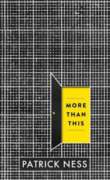
More than This
Written by Patrick Ness
Candlewick Press, 2013, 472 pp.
ISBN: 978-0763662585
The first moments after the boy’s death pass for him in a confused and weighty blur. He is dimly aware of pain, but mostly of a tremendous fatigue, as if he has been covered in layer upon layer of impossibly heavy blankets. (Ness, p. 7)
Seth drowns at the age of 17 and knows he has died—once he awakens again to find himself outside his English childhood home where he has not lived for eight years. He is confused, splayed out on the street, dressed in very little clothing. He has difficulty walking, and comes to understand that he is in this place where the electricity does not work, where the people and animals have disappeared, and where everything has been left with little forethought. Seth gives this place the only name he has for where people who have died might find themselves so totally alone—hell. Eventually, however, Seth discovers he is not alone, which could be a much more dangerous situation. And then he begins to wonder if he has died at all.
More Than This is a gripping adventure that will keep readers wondering what is really happening with Seth as he attempts to discover what has happened to himself, his family, and those from his boyhood community. Reminiscent of the movie “The Matrix” and Asimov’s (1973) I, Robot, the story addresses issues of survival, grief, friendship, family, and perceptions as reality. Seth is a dynamic character who wrestles with which reality seems most feasible—the one in which he currently finds himself, or the one that he remembers. His memories are vivid while his current reality is lifeless, dust-covered, and terribly, terribly wrong. Readers are held in healthy abeyance along with Seth through much of the story through a plotline that creates evidence for both possibilities, a delicate feat superbly achieved by the author.
With a storyline that would engage middle and high school students, More than This makes a great companion to texts such as Feed (M. T. Anderson, 2012) or The Walking Dark (Robin Wasserman, 2013). It could also be used in a text set with books such as Sex & Violence (Carrie Mesrobian, 2013) and The Shadow of Blackbirds (Cat Winters, 2013) as a way of examining desperation and what measures people will go through to avoid pain.
Patrick Ness is the author of the acclaimed series, Chaos Walking (2009, 2010, 2011), a science fiction trilogy that is equally gripping and won the Guardian Children’s Fiction Prize and the Booktrust Teenage Prize. He is the author of award-winning A Monster Calls (2011), which is being made into a movie. He also writes for adults, including a retelling of The Crane Wife (2014) and a series of short stories in Topics About Which I Know Nothing (2010). Born and raised in the United States, Ness moved to the United Kingdom in 1999, where he teaches at Oxford University. More information about Ness can be found on his website.
Holly Johnson, University of Cincinnati, OH
WOW Review, Volume VI, Issue 3 by Worlds of Words is licensed under a Creative Commons Attribution-NonCommercial-ShareAlike 4.0 International License. Based on work at https://wowlit.org/on-line-publications/review/vi-3/
